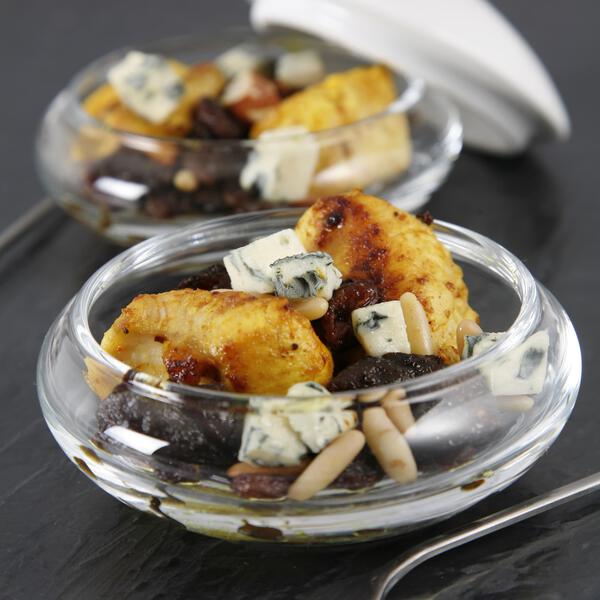Muscat de France
Wines color
Taste profile
Sweetness
Body
Acidity
Tannins
Alcohol
Table of contents
Aperitif ideas
Medal winners
Encyclopedia
Origin
According to the most renowned ampelographers, Muscat blanc à petits grains is of Greek origin. This variety conquered all of the Mediterranean, first of all establishing itself on the Mediterranean coast of France in the baggage of the Phocaeans of Marseille. The Muscat variety is complex, as there are other Muscats Blancs (Muscat of Alexandria and Muscat Ottonel) and they are highly varied in terms of genetic structure.
Aromas
The heady, explosive aromas of Muscat blanc à petits grains reflect the crisp flavors of the grapes. This varietal aroma of this grape is wild and musky, a slightly animal-like expression of rosewood and litchi. These notes are accompanied by fruitier touches –grapefruit, fresh-squeezed orange juice and exotic fruits - as well as floral notes such as jasmine, lemon grass and verbena.
Wines profile
Muscat blanc à petits grains is used to produce dry white wines, natural sweet wines (vins doux naturels) and sparkling wines. It can also be used in blends (in small percentages) to lend aromatic nuances to more neutral wines. When its yields are limited, Muscat blanc à petits grains has a high sugar potential with well-balanced acidity and intense flavors, at once powerful and delicate.
Cultivation areas
A Mediterranean variety par excellence, it has managed to adapt to various regions as long as they are warm and sunny. In France, Muscat is a variety grown on the Mediterranean littoral. It is also found in smaller quantities near the Rhine in northeastern France, where it is gradually being replaced by Muscat Ottonel for the production of dry wines. Though highly aromatic dry wines are not currently in fashion, Muscat à petits grains has seductively exotic aromas, and production of this variety is steadily increasing.
Precocity
Muscat blanc à petits grains buds early, at the same time as Chasselas, the benchmark grape variety. In terms of ripening, however, it is considered late, reaching full ripeness 2 after Chasselas. This makes it a Period II grape variety.
Vigor
This moderately vigorous grape variety requires a strong concentration of sugar in order to provide its highly sought after varietal aromas. Thus, yields must be limited. Muscat blanc à petits grains grows upright to semi-upright, and it must be pruned short. It is difficult to grow, as its yields are prone to fluctuate and Muscat tends to have low acidity at higher yields. Wines made with Muscat are delicious when young, with an explosion of aromatic sensations, but they cannot be kept for long, due to their relatively low acidity, which quickly makes them dull and less interesting.
Soils
Muscat blanc à petits grains is particularly well suited to limestone soils, but it can also to adapt to various levels of clay content.
Climat
Muscat blanc à petits grains, like all of the Muscats, requires heat and a lot of sunlight. It needs a long vegetative growth period, and must ripen slowly. It does not take well to humidity due to its susceptibility to disease. It withstands drought less well than Muscat of Alexandria, and in France is planted in the coolest part of the Mediterranean area.
Susceptibility to diseases and pests
Muscat blanc à petits grains is susceptible to oidium, gray mold and hymenoptera. It is furthermore highly susceptible to mites.
Use
This wine grape is also used as a table grape. It also makes natural sweet wines (vins doux naturels), sparkling wines and, more rarely, brandies. It is not used to produce sweet liqueur–like wines, however, as the noble rot Botrytis Cinerea destroys Muscat’s highly sought-after varietal aroma.
Descriptive elements
To recognize Muscat, we can see that the tips of its young shoots are densely covered in flat-lying hairs. Its young leaves have a strong bronze color, and new shoots have long tendrils. Its adult leaves are dark green and orbicular with three or five lobes, and a V-shaped petiolar sinus that is slightly open or even closed. The teeth of the leaf blade are medium to large with rectilinear sides. They are medium-length to long in relation to their width at the base. The veins of Muscat's leaf blade have no anthocyanic pigmentation. The leaf has a bubbled appearance, and is often wavy between the main veins and the petiolar point. Its lower surface is sparsely covered with upright and flat-lying hairs. Muscat blanc à petits grains has small clusters, but contrary to what its name suggests, its berries are medium sized.
Clonal selection in France
The thirteen approved Muscat à petits grains blancs clones (specifically named Muscat à Petits Grains Blancs B) are numbers 154, 155, 156, 157, 452, 453, 454, 455, 576, 577, 578, 579 and 826. A conservatory of 110 clones was planted in the Aude region in 1995. Recent prospection led to the setup of a second conservatory of one hundred clones in the vineyards of Die (Drôme) in 2007.






